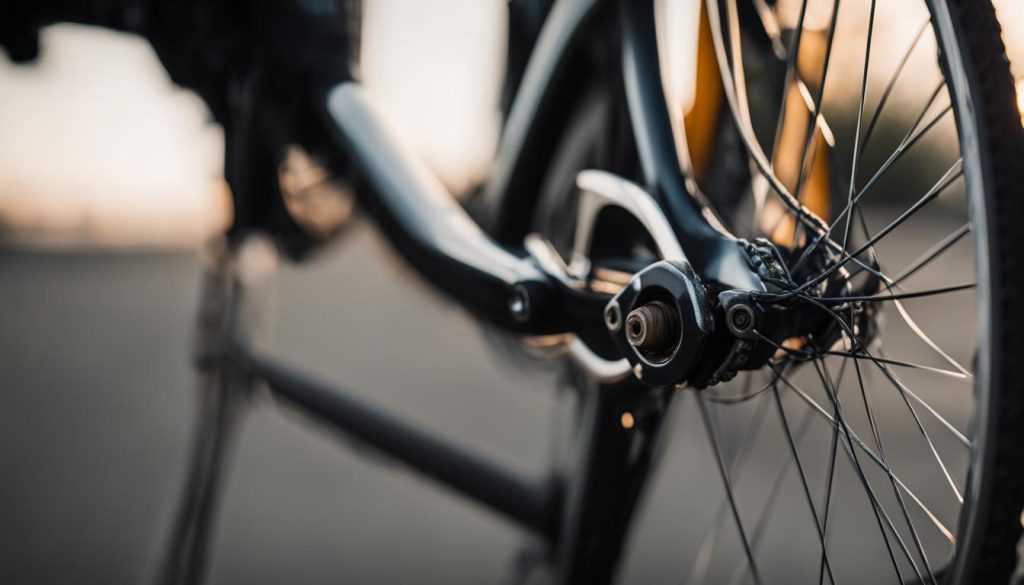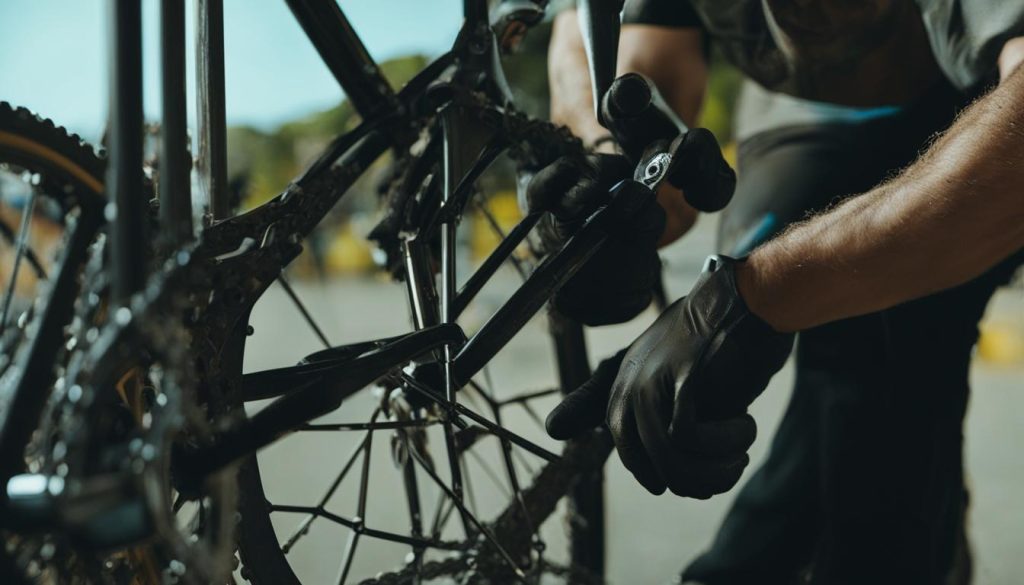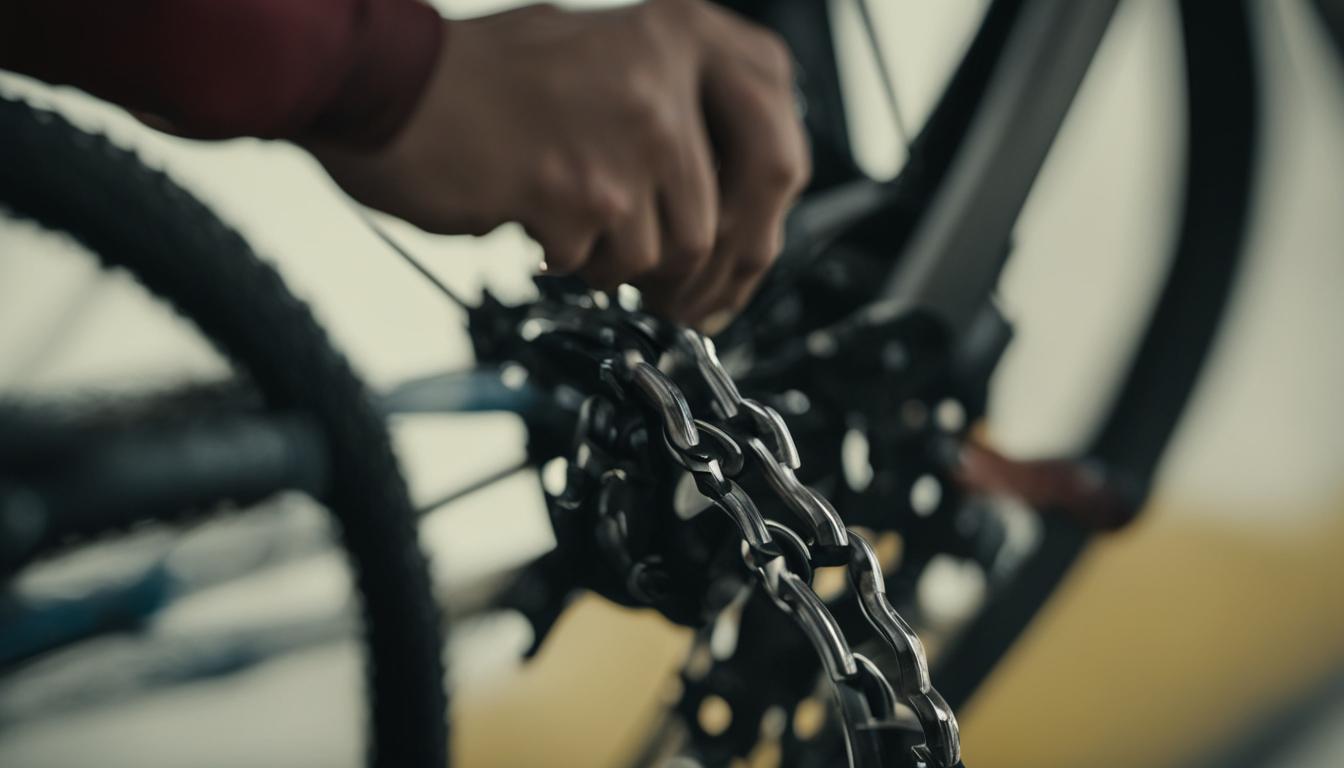Knowing how to change your bicycle chain is an essential skill for any cyclist or home mechanic. Chains are one of the consumable parts of your drivetrain and wear with use over time. By staying on top of maintenance and regularly replacing your chain, you can ensure smooth and efficient cycling.
In this step-by-step guide, we will walk you through the best way to change your bicycle chain, providing tips for replacing it and recommending the tools you’ll need. Additionally, we will highlight common mistakes to avoid and discuss the benefits of changing your bicycle chain regularly.
Read More : The Most Common Bicycle Maintenance Mistakes
Key Takeaways:
- Changing your bicycle chain is an essential skill for home mechanics and cyclists.
- Regularly replacing your chain can help prolong the lifespan of your drivetrain components.
- Proper chain maintenance, such as cleaning and lubricating, is crucial for optimal performance.
- Ensure chain compatibility with your drivetrain and select the appropriate size and type of chain.
- Don’t forget to properly size the new chain and route it correctly through the rear derailleur.
How to Check and Maintain Your Bicycle Chain
Checking Your Bicycle Chain
Regularly checking your bicycle chain is essential to ensure its optimal performance. Here are some simple steps to follow:
- Use a chain wear tool to check for excessive chain stretch. If the tool drops between the rollers, your chain is stretched and needs to be replaced.
- Measure the chain length with a ruler or tape measure. If the 12 links measure 12 1/8 inches or more, it’s time for a new chain.

Maintaining Your Bicycle Chain
Maintaining your bicycle chain is crucial for its longevity and smooth operation. Follow these tips to keep your chain in top condition:
- Clean your chain regularly using a degreaser and a brush. This will remove dirt and grime that can cause wearing and affecting shifting performance.
- Lubricate your chain with a high-quality chain lubricant after cleaning. Apply a small amount to each chain link, wiping off any excess.

Chain Compatibility and Length
When it comes to replacing your bicycle chain, chain compatibility and length are important considerations. Here’s what you need to know:
- Ensure that the new chain is compatible with your bicycle’s drivetrain. Different drivetrain setups require specific chains.
- Sizing a new chain is crucial to ensure proper function. Use the old chain as a reference or the “small-small” method to determine the correct length.
Summary
Regularly checking and maintaining your bicycle chain is vital for optimal performance and longevity. Use a chain wear tool to monitor chain stretch, clean and lubricate regularly, and ensure compatibility and proper sizing when replacing the chain. By taking these steps, you’ll enjoy smoother shifting and prolong the lifespan of your drivetrain components.
Conclusion
In conclusion, knowing how to change your bicycle chain is a crucial skill for any cyclist or home mechanic. By staying on top of maintenance and regularly replacing your chain, you can extend the lifespan of your drivetrain components and ensure a smooth and efficient cycling experience.
Remember to always check the compatibility of your new chain with your drivetrain and properly size it for your bike. Maintaining your chain through regular cleaning and lubrication is also essential for its longevity.
By following our step-by-step guide and using the recommended tools, you can easily replace your bicycle chain and enjoy an enhanced biking experience. Taking these simple yet important steps will help improve your overall cycling performance and ensure optimal efficiency.
So, don’t forget to change your bicycle chain regularly. It’s a small task that can make a big difference in your riding enjoyment and the longevity of your bike’s drivetrain. Happy cycling!
FAQ
Why is knowing how to fit a bicycle chain important?
Knowing how to fit a bicycle chain is an essential skill for any home mechanic.
Why do bicycle chains wear over time?
Chains are one of the consumable parts of your drivetrain and wear with use over time.
How can I slow down drivetrain wear?
You can slow down drivetrain wear by staying on top of maintenance, such as cleaning your chain regularly and checking it for wear using a chain-checker.
Are the steps for replacing a chain the same for road bikes and mountain bikes?
Yes, the steps for replacing a chain are relevant to road bike and mountain bike groupsets.
What tools do I need to replace a chain?
You will need protective gloves, a chain breaker tool, quick link pliers (if your chain uses a quick link), a piece of broken spoke or zip tie (optional), a new chain, and chain lubricant.
Why is it important to check chain compatibility?
It’s important to check chain compatibility with your drivetrain.
What are the different shapes and sizes of chain breaker tools?
Chain breaker tools come in various shapes and sizes to suit different price points and applications.
Where should the rear derailleur be shifted before starting the chain replacement process?
The rear derailleur should be shifted into the smallest cog on the cassette before starting the chain replacement process.
How do I remove the chain?
You can remove the chain by locating the quick link or joining pin and using the appropriate tools to unlock it.
Why is sizing a new chain important?
Sizing a new chain is important to ensure it is the correct length for your bike and drivetrain combination.
How can I determine the correct chain length for my bike?
Different methods can be used to determine the correct chain length, such as comparing it to the old chain or using the “small-small” method.
What should I check after installing a new chain?
It’s crucial to ensure the chain is routed correctly through the rear derailleur and that it is the correct length to operate in any gear.
How can I check if my chain needs to be replaced?
Use a chain wear tool to check your chain for excessive stretch. If it drops between the rollers, it means your chain is stretched and should be replaced. Another way to check for chain stretch is to measure the chain with a ruler or tape measure. If the 12 links measure 12 1/8 inches or more, you need to replace the chain.
How can I prolong the lifespan of my chain?
Regularly maintaining your chain by cleaning and lubricating it can help prolong its lifespan.
What should I consider when selecting a new chain?
Check the compatibility of the new chain with your drivetrain and make sure to select the appropriate speed-specific chain.
What should I be careful of when using a master link?
If your chain uses a master link, make sure to connect the inner and outer links correctly.
Are there any specific tools required for certain chains?
Chains with special replacement pins or master links may require specific tools for repair.
How often should I check and replace my chain?
Check your chain regularly for signs of wear and replace it when necessary to prevent further damage to your drivetrain.
Why is learning how to change a bicycle chain important?
Learning how to change your bicycle chain is an essential skill for any cyclist or home mechanic.
How can changing my bicycle chain benefit me?
Proper maintenance and regular replacement of the chain can help prolong the lifespan of your drivetrain components and ensure smooth and efficient cycling.
How can I easily replace my bicycle chain?
By following the step-by-step guide and using the recommended tools, you can easily replace your bicycle chain and enjoy an enhanced biking experience.
What are the key takeaways for changing a bicycle chain?
Remember to check chain compatibility, properly size the new chain, and maintain your chain regularly to ensure optimal performance.
Why should I change my bicycle chain regularly?
Changing your bicycle chain regularly is a simple yet important task that can help improve your overall biking experience.

